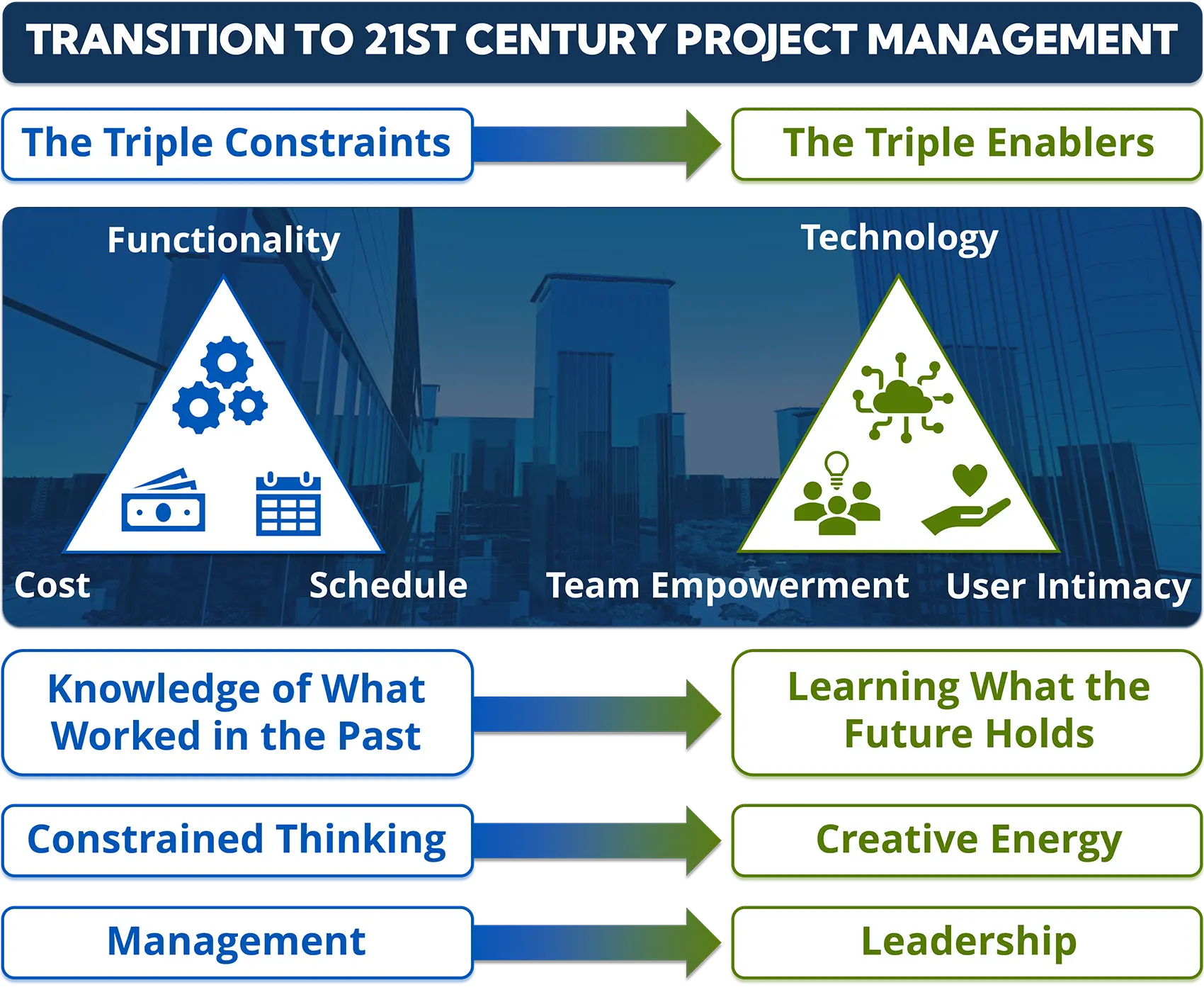Project management has a long history – from building structures to building systems to building "systems of systems," from the Colosseum to the skyscraper to the fighter jet. Until the 19th century, project management was driven by "animal spirits." There was a goal, and hell or high water wouldn't stop them from achieving it.

But in the mid-20th century, project management became a formal business and an engineering discipline with an attendant growth in formal training. A touchstone of this discipline was the triangle of the triple constraints: Managing functionality, cost, and schedule was the path to project success. It became virtually impossible (and still is) to take a project management course without addressing the triple constraints in the first chapter. But doesn't "constraints" sound a little, well, constraining? Who wants to be constrained when the path to creativity is wide open?
In the 21st century, a new mindset is required. To achieve project success in today's complex and competitive world, functionality must evolve into the application of today's technologies, schedule management must evolve into customer intimacy, and cost control must evolve into team empowerment. In short, modern project managers must disregard constraints and embrace creativity. This transition from constraints to creativity is a must to train and educate today's successful project leaders.

Technology
The functionality dictated by the triple constraints is referred to as "scope" in the 20th-century project management lexicon – scope is what we are committed to deliver. Another inspiring project management word from the 20th century is "deliverables." But the deliverables in any era are based on the technologies of that era. Roman cement for the builders of the Colosseum, energy conservation for the architects of skyscrapers, and virtual environments for the training of fighter jet pilots.
To all the project managers out there, I ask you: What technologies are you delivering? Yesterday's, today's, or tomorrow's? Twenty-first-century project managers are tracking the technologies that will disrupt (not "can," but "will") their business domains or industry sectors. The only technology constant since the industrial revolution is continuous innovation. Best to be in front of it. How will machine learning, data science, artificial intelligence, virtual environments, and renewable energy (the list goes on) affect what you deliver during the rest of your career? I urge all project managers to consider this question seriously.
User Intimacy
The 21st century began with the Agile Manifesto – and that concept has had legs. I can't imagine a 21st-century project manager not being active, or at least fully conversant, in this development mindset. The figure below shows Agile in direct contrast to the traditional approaches of the 20th century.

In the traditional approach, the project manager predicts the future and knows (or thinks they know) what the user needs. Nevertheless, the schedule moves to the right. Nevertheless, the cost grows. Nevertheless, the customer is unhappy. With an Agile approach, the project manager learns what brings value to the customer by gathering user input and starts on the path of user intimacy and business value.
Another way to imagine user intimacy is through the concept of Itamae, the Japanese word for sushi chef. If you return to the restaurant of a master sushi chef, the chef will show respect by placing a dish in front of you before you even look at the menu. When you exclaim, "How did you know I would like this?" the chef will reply, "Of course, I knew you would like it; you are my customer." Under the concept of Itamae, a customer is someone whose delights you can anticipate. Does your organization (or you) have customers or buyers? In our competitive 21st-century world, customers and users expect to be delighted. Best to learn how.
Team Empowerment
Team empowerment means that all team members pull in the same direction and collaborate through a robust set of modern productivity tools. Both dimensions are in the 21st-century project manager's job jar. Consider the iron filing test when it comes to pulling in the same direction. Imagine dumping iron filings from a jar onto a flat piece of paper. The filings randomly point in all directions. Place a horseshoe magnet under the paper, and all fillings now align along the direction of the magnet's north/south pole. Think of them as pointing to the future.
Your presence as a project manager on the team must be as strong as that horseshoe magnet. Likewise, your communication of the project's goal must be as strong as that horseshoe magnet -- a skill that admittedly predates the 21st century but is all the more relevant today. Think of the clear goal expressed by President Abraham Lincoln in the Gettysburg Address, by Winston Churchill in his WWII speeches to Parliament, or by Martin Luther King Jr in his "I Have a Dream" speech. Note that King didn't call it the "I Have a Plan" speech. Plans built in the present change; dreams of the future endure.
Effective project managers of the 21st century must provide a robust collaboration platform that allows the team to thrive in today's competitive environment. Tools that continue to deliver productivity in the hardware and software domains include model-based design, virtual environments, and, sooner than we expect, artificial intelligence. In addition, technologies that answer your user's needs can also empower your development team.
The Creativity Challenge
I have always thought of project management as a creative endeavor. By definition, a project builds something that did not previously exist. In the past few minutes, I have asked project managers to put aside the green-eye shades of functionality, schedule, and cost constraints and challenge themselves instead to see their world through the lens of critical enablers. Making it personal, are you aggressively evaluating the technologies that will disrupt your planned future? Are you continuously adding value that delights your user? Is every team member inspired to meet your communicated goal, and have you invested in a tool suite that allows them to do so?
And, when necessary, do you call up your team's animal spirits?


